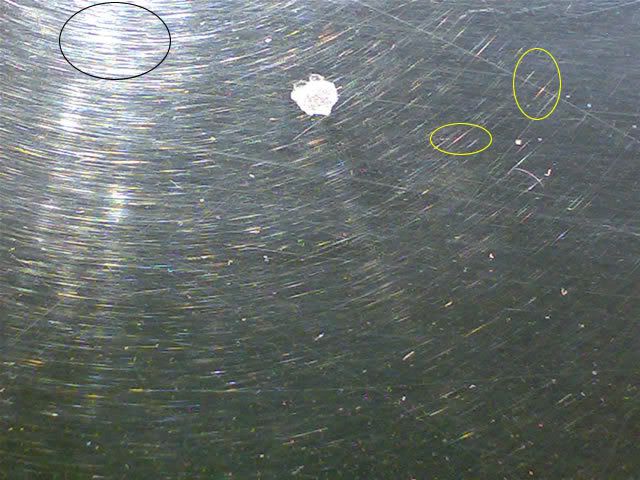Hi Everyone.
This has been a real confusion and I don't really believe in this one. I was having some discussion with a person about swirl marks who told me that swirls have a different lighting when they are covered with a product like a polish or a wax.
Here's a picture that clears up a little more what I try to say:

Supposedly, when you wax or polish AND you instill new swirls, the lighting looks like when you see a rainbow, like where the yellow circled areas are, while untreated areas show light like in the black circled part.
He also said that this is because swirl marks are supposedly instilled in the wax or sealant, and that's why the "rainbow" lighting effect is achieved (as shown in the yellow circled parts of the picture.
As far as I know, dust particles are big enough to abrade a wax and a sealant layer, and to abrade paint even if it's protected. My questions here are:
Do waxes and sealants really have some role in how light reflection (see colored "rainbow-like" reflection) is emitted by a swirl mark?
Is everyday Dust capable of just scratching a wax or sealant layer without scratching the paint at all?
Are swirl marks appreciated differently regarding light reflection in a base coat paint than in a clear coat paint?
I know that waxes and glazes may fill swirls and thus, reduce the reflection of the defect. In this case the swirl mark, but since this thing this guy told me doesn't convince me at all, and especially when this picture I'm showing is from and untreated area (just damaged paint ) and shows the lighting this guy says it can be achieved when paint has a protective layer over it. But I'd like to hear the opinion from the pros to really know if he is correct or if he is saying false things.
) and shows the lighting this guy says it can be achieved when paint has a protective layer over it. But I'd like to hear the opinion from the pros to really know if he is correct or if he is saying false things.
Thanks in advance for attending this post, And I Apologize if it's a little too complicated.
This has been a real confusion and I don't really believe in this one. I was having some discussion with a person about swirl marks who told me that swirls have a different lighting when they are covered with a product like a polish or a wax.
Here's a picture that clears up a little more what I try to say:

Supposedly, when you wax or polish AND you instill new swirls, the lighting looks like when you see a rainbow, like where the yellow circled areas are, while untreated areas show light like in the black circled part.
He also said that this is because swirl marks are supposedly instilled in the wax or sealant, and that's why the "rainbow" lighting effect is achieved (as shown in the yellow circled parts of the picture.
As far as I know, dust particles are big enough to abrade a wax and a sealant layer, and to abrade paint even if it's protected. My questions here are:
Do waxes and sealants really have some role in how light reflection (see colored "rainbow-like" reflection) is emitted by a swirl mark?
Is everyday Dust capable of just scratching a wax or sealant layer without scratching the paint at all?
Are swirl marks appreciated differently regarding light reflection in a base coat paint than in a clear coat paint?
I know that waxes and glazes may fill swirls and thus, reduce the reflection of the defect. In this case the swirl mark, but since this thing this guy told me doesn't convince me at all, and especially when this picture I'm showing is from and untreated area (just damaged paint
 ) and shows the lighting this guy says it can be achieved when paint has a protective layer over it. But I'd like to hear the opinion from the pros to really know if he is correct or if he is saying false things.
) and shows the lighting this guy says it can be achieved when paint has a protective layer over it. But I'd like to hear the opinion from the pros to really know if he is correct or if he is saying false things. Thanks in advance for attending this post, And I Apologize if it's a little too complicated.



 "
"
 Maybe that's why a clear coat finish is harder to maintain :P. As Mike Phillips said:
Maybe that's why a clear coat finish is harder to maintain :P. As Mike Phillips said:
Comment